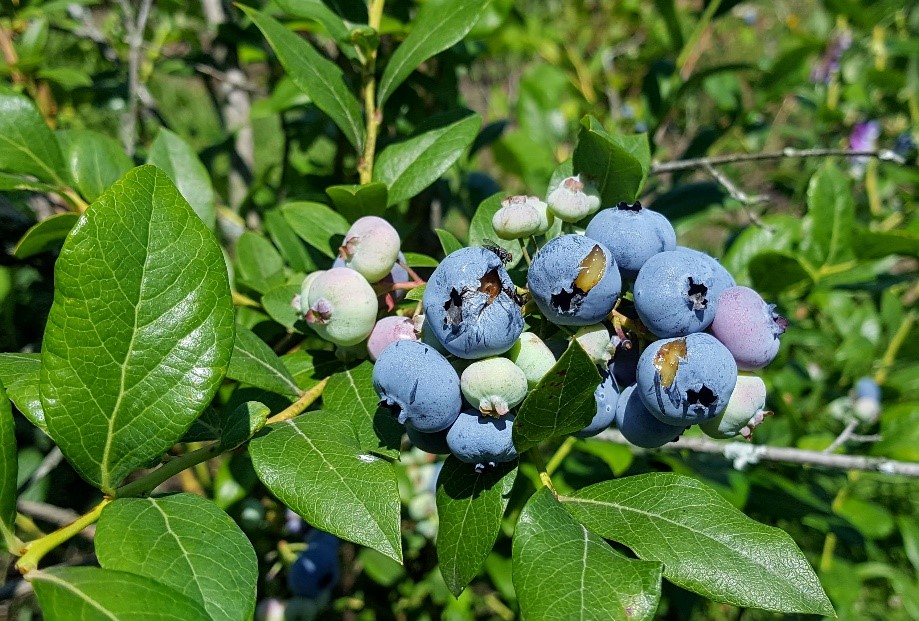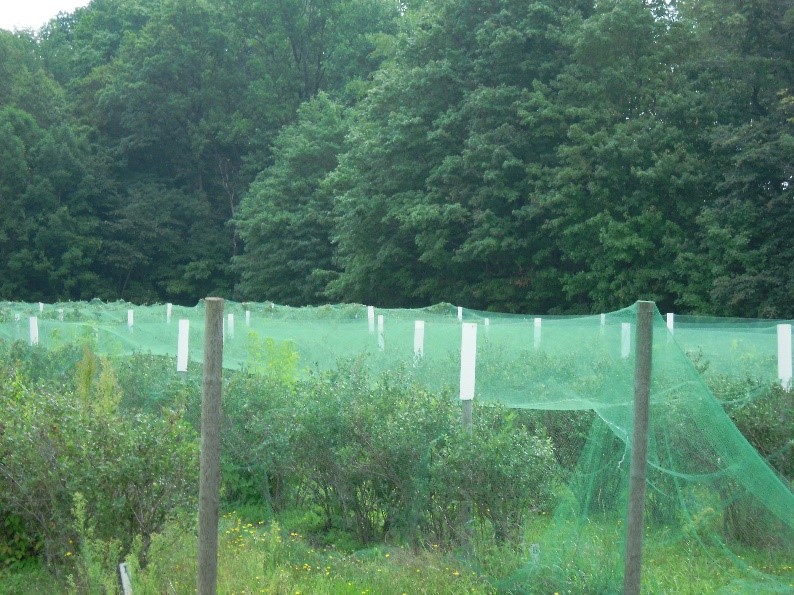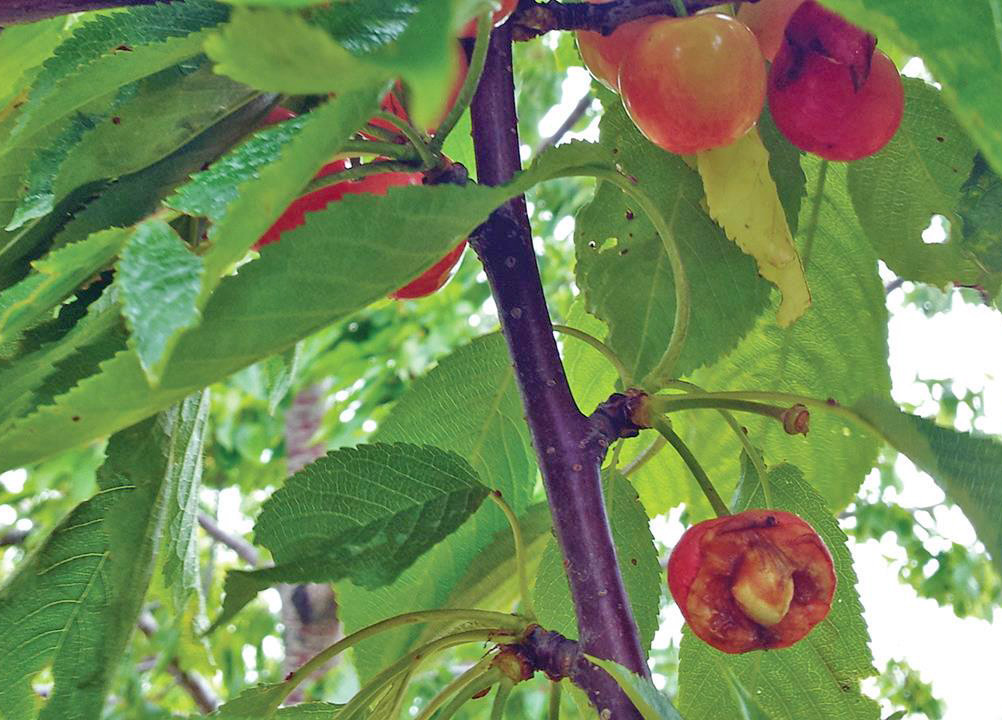Managing bird damage on fruit farms
Preventing habitual behavior is critical for effective bird damage management.

Many birds, especially robins, starlings, cedar waxwings and grackles, eat fruit—wild or farmed—when it is available. Robins generally feed as individuals, waxwings in small flocks up to 10 birds, while grackles and starlings often form large flocks, especially in fall and winter. The time when fruit matures impacts the amount of damage. Fruit that ripens early in the season or geographically isolated plantings may be damaged more often because they provide a scarce or concentrated source of fruit in the area.
Fruit damage by birds may appear as multiple peck marks, partially eaten fruit or the fruit may be completely gone. Starlings and robins can remove an entire fruit such as a blueberry or cherry. Cedar waxwings often leave characteristic V-shaped marks on blueberries that remain on the bush. Birds may knock fruit to the ground where it is unharvestable. Damaged fruits that fall to the ground or remain on the plant can harbor diseases and insect pests, which can threaten the remaining crop.

Legal status
Robins and cedar waxwings are protected by the Federal Migratory Bird Treaty Act and can be taken only with a federal migratory bird depredation permit. Grackles are also federally protected, however, there is a provision in the Act allowing crows and grackles to be trapped or killed “when found committing or about to commit depredations upon ornamental or shade trees, agricultural crops, livestock or wildlife.” Starlings are not protected and can be killed without a permit. All these bird species can be harassed without a permit.
Management
No single damage management method works all the time or in all settings. Generally, management methods should be combined so that one method enhances the effects of another.
Exclusion

Excluding birds with netting is considered cumbersome and expensive by many growers and rejected out of hand. It is the most effective means to prevent fruit damage. For small plantings where fruit losses may exceed 30% or 50% of the fruit or more, the netting may pay for itself in a year or two by doubling the harvestable yields.
Netting must be properly installed and maintained to completely exclude the birds. Attaching the netting to a frame allows you to work and harvest the plants without having to remove the net. Anchor the netting to the ground to prevent birds from entering under the net. Merely draping netting over the plant allows the birds to access fruit through the net and fruit is often pulled off the plants when draped nets are removed from the plant.
Biological control
Keeping birds out of a planting using birds of prey such as hawks and falcons is attractive for several reasons. Hiring a registered falconer to patrol the planting is very effective and often very expensive. In an effort to attract native predators, some growers have erected nest boxes for kestrels, a small falcon found in the Great Lakes region, to deter birds from visiting the crop area. They nest from April to August, which puts them in and around orchards when birds might be damaging fruit. This method is inexpensive and doesn’t require much time investment after the nest box is installed. On the downside, there’s no guarantee kestrels will use the box and sometimes starlings will use the boxes.
Repellents
Growers who often use pesticides to protect fruit from insects and diseases would like something to spray on the fruit to protect it. There is a commercial repellent, Avian Control, for protecting fruit from birds. The active ingredient is methyl anthranilate, a contact irritant that affects all bird species. Methyl anthranilate is an immediate irritant that birds do not learn to ignore, so birds do not have to learn to avoid treated areas. It can be applied by fogging or ground spray equipment.
Like all pesticides, one single application may not provide season long control. Repeated applications are needed if the crop is vulnerable over several weeks. These repellents are registered pesticides and applicators need to comply with label instructions.
Harassment
Birds can be harassed with various methods such as pyrotechnics (screamers, bangers), propane cannons, hawk kites, reflective ribbon and scare balloons. Harassment is probably the most common method used to repel birds. Birds are intelligent and become habituated if these methods are not varied or moved frequently. Scarecrows have been used for centuries, but usually have limited value in deterring birds unless they are enhanced by adding movement or including additional control measures such as lethal control.
Some producers have found a benefit using air dancers—20-foot tall inflatable tube displays. They offer a large active presence and don’t require a great deal of effort once they are operating. On the other hand, they may cost approximately $300, require a power source to operate the blower and are less active when they get wet. Harassment methods like air dancers or noise makers can cause tensions with neighbors and may frighten or annoy dogs.

Shooting
Shooting is a time-consuming approach as birds can be persistent, especially when fruit is ripe. Except for starling, grackles and crows, the shooting of all other bird species requires a federal migratory bird depredation permit. You need to accurately identify the offending species before shooting. Growers may find the Cornell Lab of Ornithology) helpful in identifying species.
Considerations
Most people like birds and birds have significant cultural value in our society. Consider the social implications of bird control strategies. Always use the least disruptive control method. Good communication between neighbors will lessen negative social implications of bird management. Preventative control that prevents habitual behavior is critical for effective bird damage management. Control is much more difficult after feeding patterns have become established and the birds know where your fruit is. Seldom is only one bird species eating fruit in an orchard or field. Control methods applicable for one species are often carryover to other bird species.
Other birds, such as crows and gulls, that damage fruit have not been discussed here. The pecking damage appears larger, consistent with their larger size, and those species are likely to cause more fruit to fall to the ground. With large birds, limb breakage is also a problem. The methods of reducing damage would be much the same as discussed here.
Visit the Michigan State University Wildlife Management website for additional fact sheets on managing other wildlife, including additional bird species.
This work was supported by the USDA National Institute of Food and Agriculture, Crop Protection Pest Management Program and the North Central IPM Center (2014-70006-22486) and (2017-70006-27175). Any opinions, findings, conclusions or recommendations expressed in this publication are those of the author(s) and do not necessarily reflect the view of the U.S. Department of Agriculture.



 Print
Print Email
Email




